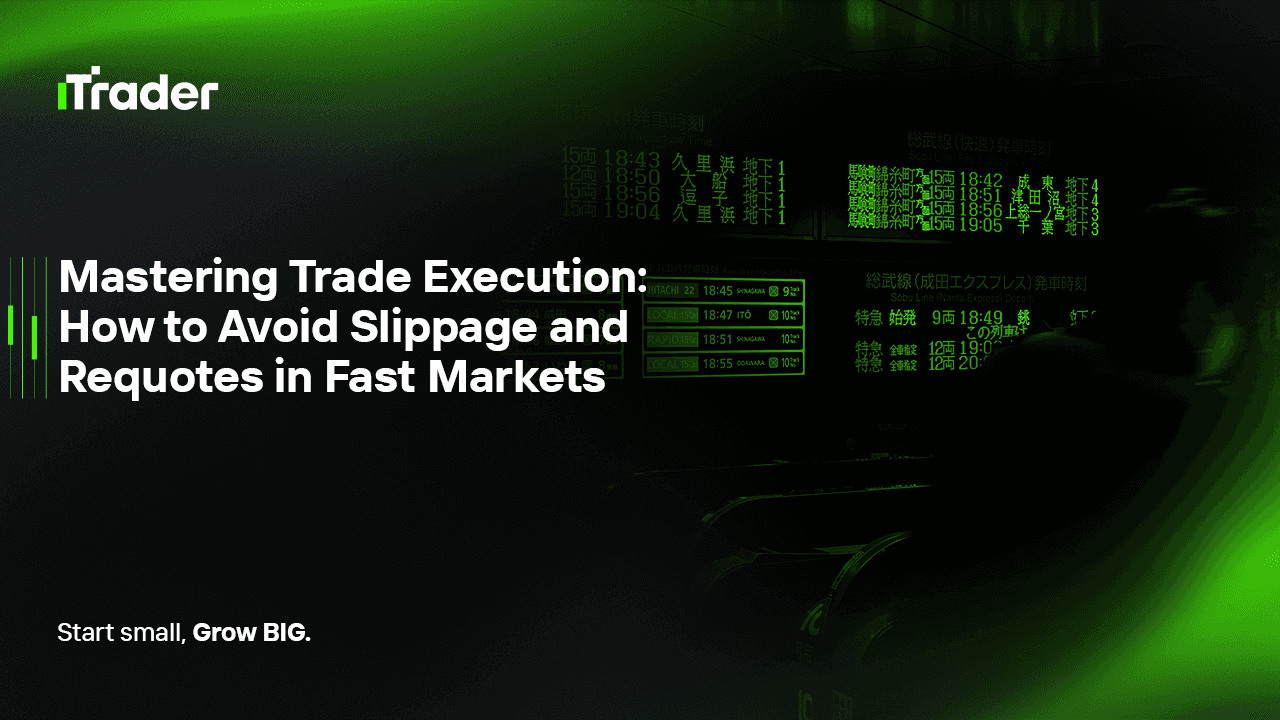2025-09-22
Every trader knows the feeling: you spot the setup, hit the buy button, and then… your entry isn’t where you expected. The market moved a little, your broker slipped the order, or worse—they sent you a requote. Suddenly your risk looks bigger, your reward-to-risk ratio is skewed, and frustration creeps in.
For retail traders this might be an annoyance, but for prop traders it’s a different story. Slippage and requotes can be the difference between passing or failing an evaluation. When a firm sets strict drawdown rules, even small execution errors matter.

In this blog, we’ll break down what slippage and requotes really are, why they hit prop traders harder, and what you can actually do to manage them. Think of it as a trader-to-trader conversation about one of the least glamorous but most important parts of the game: getting filled at the right price.
Execution isn’t just clicking “Buy” or “Sell.” It’s the whole chain:
Along that chain, two things can happen:
If you’ve ever traded around big news events, you’ve definitely seen one—or both.
Slippage is simply the gap between your intended price and your actual fill.
Example: You buy EUR/USD at 1.1000. Instead of 1.1000, you get filled at 1.1003. That’s a 3-pip slippage against you.
A requote is when your broker says: “Sorry, we can’t fill you at that price. Here’s a new one—do you want it?”
Example: You try to buy GBP/USD at 1.2500. The broker responds: “New available price: 1.2505.” You must accept or cancel.
Requotes are most common with dealing desk brokers, especially when markets are moving fast. They’re frustrating because they interrupt your flow—you either chase the market or miss the trade.
For a retail trader, slippage and requotes just eat into profit margins. For a prop trader, they can break the rules of the game.
That’s why execution quality is part of being a professional. Strategy alone isn’t enough.
Here’s the truth: you’ll never fully escape slippage. It’s part of trading. What matters is how you prepare for it and respond when it happens.
The traders who survive in prop aren’t the ones with zero slippage—they’re the ones who accept it and keep their discipline intact.
Execution isn’t just a technical detail—it’s part of risk management.
Picture this: it’s Nonfarm Payroll Friday. Your system calls for a breakout buy at 1.0800 in EUR/USD.
For many traders, this kind of slippage is enough to break a prop evaluation. The smart play? Sit out unless your system is specifically designed for that chaos.
Good traders measure everything—including execution.
Execution data is part of your trading edge. Ignore it, and you’re trading blind.
Slippage and requotes aren’t glamorous topics. They don’t show up in flashy strategy backtests. But for prop traders, they’re deal-makers or deal-breakers.
You can’t eliminate them, but you can manage them. The keys are:
Prop firms don’t expect perfection—they expect professionalism. Managing execution is part of proving you’re ready to handle real capital.
2025 Ай Трейдер Глобал ХХК | Компанийн бүртгэлийн дугаар: 15962
Ай Трейдер Глобал ХХК нь Комор улсын Анжуан арал дахь Мутсамуду хотын Хамчакод байрлалтай. Тус компани нь Коморын Үнэт Цаасны Хорооноос (Securities Commission of the Comoros) олгосон L15962/ITGL дугаартай тусгай зөвшөөрлийн хүрээнд үйл ажиллагаа явуулдаг.
Ай Трейдер Глобал ХХК нь “iTrader” нэрийн дор үйл ажиллагаа явуулдаг бөгөөд (Форекс) арилжааны үйл ажиллагаа явуулах эрхтэй. Компанийн лого, барааны тэмдэг, вэбсайт нь зөвхөн Ай Трейдер Глобал ХХК компанийн өмч юм.
Ай Трейдер Глобал ХХК -ийн охин компани болох : iTrader Global Pty Ltd, Австралийн компанийн бүртгэлийн дугаар (ACN): 686 857 198. Энэ компани нь Opheleo Holdings Pty Ltd компанийн албан ёсны төлөөлөгч бөгөөд Австралийн санхүүгийн үйлчилгээний төлөөлөгчийн дугаар: 001315037 -тай. Австралийн санхүүгийн үйлчилгээний лицензийн дугаар: 000224485 -тай Level 1, 256 Rundle St, Adelaide, SA 5000 хаягт байршдаг. Анхааруулга: Энэ байгууллага нь энэхүү вэбсайт дээр болон дамжуулан арилжаалагдаж буй санхүүгийн (арилжааны) хэрэгсэл нийлүүлэгч биш бөгөөд ямар нэгэн хариуцлага хүлээхгүй болно.
Эрсдэлийн сэрэмжлүүлэг: CFD арилжааны хөшүүргийн улмаас хөрөнгөө хурдан алдах өндөр эрсдэлтэй тул бүх хэрэглэгчдэд тохиромжгүй байдаг.
Фанд, CFD болон бусад өндөр xөшүүрэгтэй арилжаа нь хэрэглэгчээс нарийн төвөгтэй ойлголтуудын талаар тусгай мэдлэг шаарддаг. Хөшүүрэгтэй арилжаанд оролцогчдын 84.01% нь алдагдал хүлээдгийг судалгаанууд харуулдаг тул хөшүүрэгтэй арилжаанд орохоос өмнө хөрөнгөө алдах маш өндөр эрсдэлтэй болохыг анхаарна уу.
iTrader нь аливаа иргэн, хуулийн этгээдийн өмнө xөшүүрэгтэй арилжааны эрсдэл, алдагдал, бусад хохирлыг бүхэлд нь хариуцахгүй болохыг мэдэгдэж байна.
Энэхүү веб сайтын мэдээ, мэдээлэл нь зөвхөн мэдлэг түгээх зорилготой тул хэрэглэгч та бие даан шийдвэр гаргана уу.
Хязгаарлалт: iTrader нь вэбсайт болон үйлчилгээгээ тухайн орны хууль тогтоомж, дүрэм журмаар хориглосон орнуудад оршин суугчдад чиглүүлдэггүй. Хэрэв та энэхүү вэбсайтыг ашиглахыг хориглосон оронд байгаа бол вэбсайт болон үйлчилгээг ашиглахдаа тухайн орны хууль тогтоомжид нийцэж байгаа эсэхийг шалгах үүрэгтэй. iTrader нь вэбсайтынхаа мэдээлэл бүх оронд тохиромжтой эсэхийг баталгаажуулдаггүй.
Ай Трейдер Глобал ХХК нь зарим улс орны иргэдэд үйлчилгээ үзүүлэхээс татгалздаг болно. Жишээлбэл: АНУ, Орос, Бразил, Канада, Израйл, Иран.